Domain Archaea
Domain Archaea Characteristics:
Archaea Domain
- They are the most primitive organisms.
- Members of this domain have prokaryotic cells.
- Cell membranes have branched hydrocarbon chains attached to glycerol by a type of linkage called ester linkage.
- Certain chemical constituents of cell membrane help them to withstand extreme temperature and highly acidic environment.
- Peptidoglycan is absent in cell wall.
- Extreme halophiles (organisms thriving in highly saline environment) and hyperthermophiles (organisms thriving in extremely hot environment) are best examples of Archaea.
Archaebacteria

Read and Learn More: WBCHSE Notes for Class 11 Biology
Kingdoms included: Domain Archaea contains only one kingdom called Archaebacteria. This kingdom is further divided into three groups—methanogens, halophiles and thermoacidophiles. These groups have been discussed later in the chapter.
Domain Bacteria
Domain Bacteria Characteristics:
- This group includes prokaryotic bacteria.
- Cell membranes have unbranched fatty acid chains attached to glycerol by a type of linkage called ester linkage.
- Peptidoglycan is present in cell wall.
- Most of them are decomposers, some are autotrophic in nature.
- Most of them cause diseases in higher organisms but some may be beneficial.
Kingdoms included: This group also has a single kingdom called Eubacteria. This kingdom is again subdivided into four groups— Proteobacteria (Rhizobium 1 sp.), Cyanobacteria (Nostoc sp.), Spirochaetes (Treponema sp.), Firmidicutes (Clostridium sp.) and Mycoplasmas. These groups too have been discussed later in the chapter.
Domain Eukarya
Domain Eukarya Characteristics:
- The members of Eukarya have eukaryotic cells, which have cell membranes nearly similar to that of bacteria.
- True nucleus and membranous cell organelles are present.
- Some eukaryotes may have cell wall, but peptidoglycan is absent.
Kingdoms included: Domain Eukarya is further divided into Kingdom Protista (algae, protozoans, etc.), Kingdom Fungi (yeast, mould, etc.), Kingdom Plantae (flowering plants, ferns, etc.) and Kingdom Animalia (insects, vertebrates, etc.).
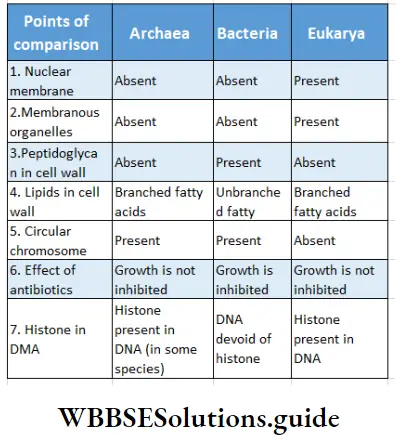
Kingdom Monera
The Kingdom comprising of the simplest unicellular, prokaryotic living organisms, is known as Kingdom Monera.
Kingdom Monera Distribution: The members of kingdom Monera are present in all types of environment. Some of them are even present in extremes of environment (such as high temperature, saline, alkaline or acidic environment, etc.).
Kingdom Monera General features:
- Cell nature: These organisms are prokaryotic. They are simple, unicellular and microscopic. They may form filament or thread-like structure.
- Cell shape and size: Cell shape is generally characteristic of a given bacterial species. They are microscopic, with a volume of about 0.2-10.0pm3, length being 0.1-0.5pm.
- Cell wall: Cell wall is present in some organisms. It is generally made up of peptidoglycans. In case of archaebacteria, the cell wall is made up of proteins. The cell wall is absent in case of mycoplasma.
- Cytoplasm: The cytoplasm appears as colourless jelly. It contains nuclear material, non-membranous cell organelle and gas vacuoles. True cytoskeleton is absent but may contain primitive cytoskeleton.
- Nuclear material: They do not possess a definite nucleus or a nuclear membrane. The nuclear material without the nuclear membrane and nucleus, is known as nucleoid.
- Genetic material: The genetic material is constituted of naked double-stranded DNA, that remains without histone proteins. It is present within the cytoplasm. This type of DNA is known as prochromosomes.In some cases, plasmids (small DNA molecules that replicate independently) and episomes (small DNA molecules that can replicate independently as well as integrated within the chromosome) are present.
- Cell organelles: Double membrane-bound cell organelles are absent.Chloroplast is absent. The pigment-containing, membranous thylakoids remain freely suspended in the cell. These are known as chromatophores. Mesosomes are cell organelles that carry respiratory enzymes. These organelles are present in the inner lining of the cell membrane.
- Vacuoles: Gas vacuoles may be present.
- Cellular appendages: Sometimes single-stranded flagella may be present. Some of the members may also contain pili and fimbrae.
- Nutrition: Some of the members of this kingdom can synthesise their food (autotrophs), while some derive nutrition from others (heterotrophs).
- Respiration: They perform both aerobic and anaerobic types of respiration.
- Cell division: Cell division is mainly amitosis.
- Reproduction: Reproduction is asexual in nature. This occurs by budding and binary fission.Genetic recombination (exchange of genetic material between chromosomes) is observed.
- Nitrogen fixation: Some bacteria and blue-green algae have the capacity to fix atmospheric nitrogen as ammonia. They are called nitrogen fixing bacteria. Examples: Bacteria, mycoplasma, and blue-green algae.
Classification of kingdom Monera
The microorganisms in Kingdom Monera are considered the most ancient living forms on earth. The kingdom is divided into two groups—Archaebacteria and Eubacteria. These have been discussed under separate heads.
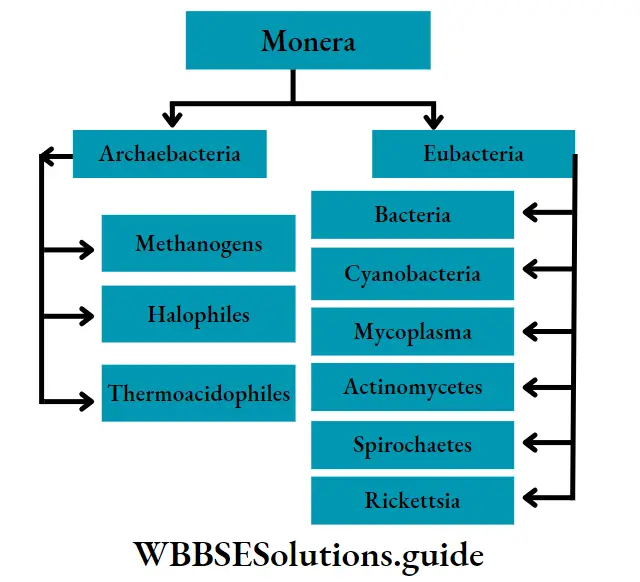
Subkingdom—Archaebacteria
Archaebacteria are small, primitive microbes that can survive in extreme and harsh environmental conditions. Hence, they are also known as extremophiles.
Subkingdom General features:
- Cell wall: Cell wall is made up of polysaccharides (other than cellulose) and proteins. In particular, their cell wall lacks peptidoglycan. Thus they may be resistant to antimicrobial agents, interfering with peptidoglycan biosynthesis.
- Cell membrane: Single-layered lipids are present in the cell membrane. Fatty acids are attached to the glycerol units by ether bond instead of ester bond.
- Nucleotides: 16S rRNA nucleotide is different from that in other organisms. RNA polymerase is also structurally dissimilar in different organisms.
- Respiration: Most of them are anaerobes in nature.
- Effect of antibiotics: They do not get affected by These have bacterial antibiotics.
- Classification of archaebacteria: Based on their habitats, the archaebacteria are classified as methanogens, halophiles and thermoacidophiles. They have been discussed under separate heads.
Methanogens
Methanogens Characteristics:
- The members of this group are anaerobic organisms. They cannot survive under aerobic conditions.
- They produce methane as a metabolic byproduct in anoxic conditions, using carbon dioxide and energy from decaying organisms.
- They live in marshy areas, such as lakes, muddy puddles, etc; They also live within the guts of the ruminant animals.
- They are responsible for the production of biogas from the dung of the above-mentioned animals.
- They are autotrophic in nature.
Examples: Methanobacterium ruminantium, Methanobacterium bryantii, Methanobacterium formicicum and Methanococcus sp., etc.
Halophiles
Halophiles Characteristics:
- The term halophile means salt loving in Greek. Therefore, as the name suggests, the members of this group live in extremely saline regions.
- Halophiles include all microorganisms that are found in acid lakes, Dead Sea and oceans.
- Their bodies contain a photoreceptor (light-sensitive) pigment called bacteriorhodopsin. This pigment helps to synthesise ATP, on absorbing light of a specific wavelength.
- The osmotic concentration of fluids within their body is high. This, in turn, helps them to survive in saline environment.
- They are aerobic in nature.
Example: Halobacterium sp., Halococcus sp., Nitzschia, diatoms, etc.

Thermoacidophiles
Thermoacidophiles Characteristics:
- They live in highly acidic, sulphur-rich, extremely hot environments.
- They prefer temperatures ranging between 70-80°C and pH between 2-3.
- They live mostly in hot springs and/or within deep ocean hydrothermal vents (fissures on the floor of the sea, from which mineral-rich, hot water flows).
- Thermoacidophiles are anaerobic in nature.
- They show autotrophic mode of nutrition and synthesise food by chemosynthesis.
Examples: Thermoplasma sp., Sulpholobus sp., Picrophilus sp., and Thermococci sp., etc.
Subkingdom—Eubacteria
Eubacteria, known as ‘true bacteria’, are unicellular, prokaryotic organisms that have a rigid cell wall.
Classification of eubacteria: Eubacteria is further divided into 6 groups—bacteria, cyanobacteria, mycoplasma, actinomycetes, spirochaetes and rickettsia. All of them have been discussed under separate heads.
Bacteria
Bacteria Definition: Unicellular prokaryotic organisms, containing primitive nucleus, that can survive under all kinds of environment are known as bacteria.
Bacteria Distribution: Bacteria are the most abundant living organisms in nature. They are found in the land, water, air, i.e., everywhere around us.
Bacteria General features:
- Bacteria are microscopic organisms containing non-organised nucleus.
- Their cell wall contains peptidoglycan.
- They contain a single, highly coiled, double-stranded DNA, that is not bound to histone proteins.
- Some amount of plasmid DNA may be present.
- Sometimes bacteria may contain cellular appendages such as flagella, pili or fimbrae.
- Membranous cell organelles are absent. However, mesosome and 70S ribosomes are present.
- Cellular respiration is carried out using mesosomes.
- These bacteria may be aerobic or anaerobic.
- They show autotrophic or heterotrophic mode of nutrition. Pigments like bacteriochlorophyll, bacterioviridin, etc., are present in autotrophic bacteria.
- Cell division is amitosis.
- Bacteria reproduce mainly by fission. Sometimes, under unfavourable conditions, they produce structures called spores. These spores germinate when conditions are favourable. They reproduce by sexual reproduction, which involves DNA transfer from one bacterium to the other.
- The majority of bacteria are decomposers in nature.
- Many of them have a significant impact on human life. They are helpful in making curd from milk, production of antibiotics, nitrogen fixation in legumes, etc. Some, however, are pathogens, causing damage to human beings, crops, farm animals and pets.
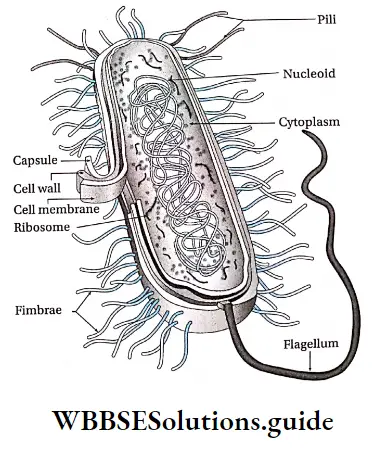
Classification of Bacteria
According to shape: Bacteria may be classified into different types on the basis of their shape—cocci (spherical shaped), bacilli (rod-shaped), spirochaetes (spiral), etc. The table below shows the different types of bacteria according to their shapes.
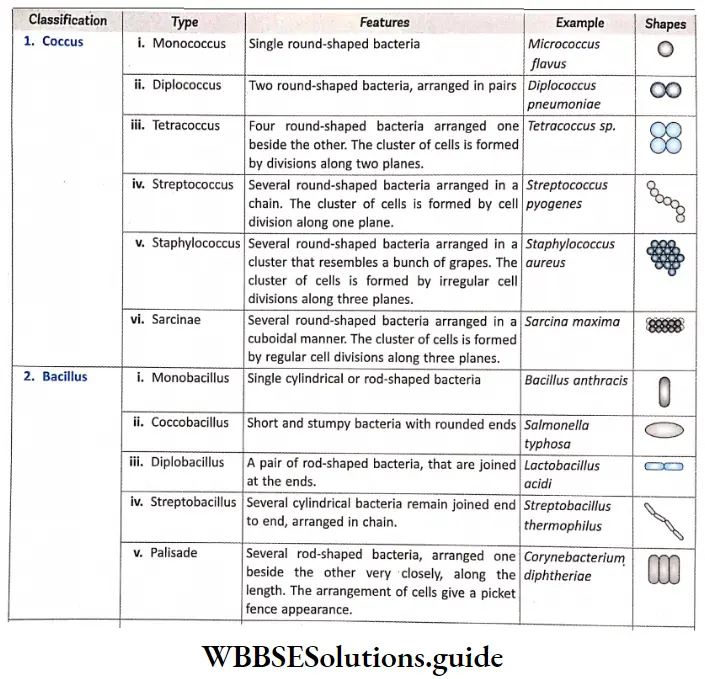
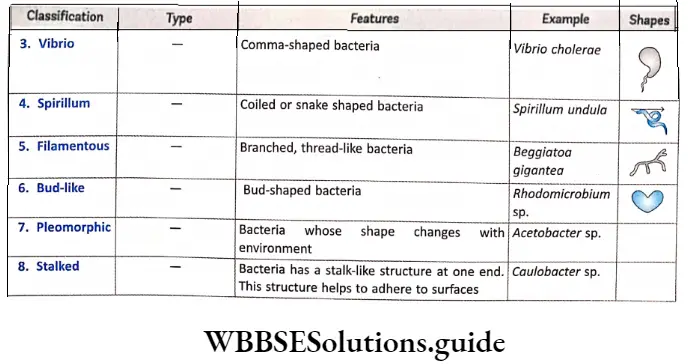
According to the staining behaviour: Bacteria may also be classified on the basis of their staining behaviour. A Based on Gram staining, bacteria may be classified into two types—Gram positive and gram negative.
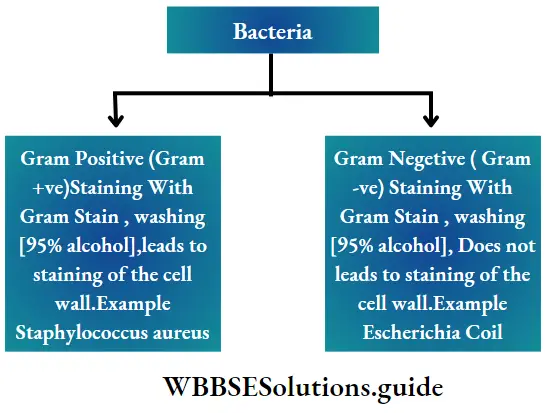
Archaebacteria Structure
Gram positive bacteria have a thicker peptidoglycan layer in their cell wall. This layer retains the crystal violet stain during the alcohol wash.
- Hence, the bacteria show violet colouration. Gram negative bacteria, on the other hand, have a thinner peptidoglycan layer in the cell wall.
- This layer does not retain the crystal violet stain but retains safranine (red-coloured counterstain). Hence after alcohol wash, the bacteria appears red instead of violet.
According to the nature of respiration: On the basis of the need of oxygen during respiration, bacteria are classified into two types— aerobes and anaerobes. Those bacteria that need oxygen are called aerobes.
Archaebacteria Kingdom
Those that do not need oxygen are called anaerobes. Both aerobes and anaerobes can be obligate or facultative. The bacteria, that cannot grow in the absence of oxygen, are called obligate aerobes (E.g.,Nitrobacter spv Thiobacillus sp.).
- The bacteria, that cannot grow in the presence of oxygen, are called obligate anaerobes (E.g., Clostridium acetobutylicum).
- In some bacteria, respiration generally takes place in the presence of oxygen, but may also take place in its absence.
- These are called facultative aerobes (E.g., Escherichia coli, Clostridium tetani). In some bacteria, respiration usually takes place in the absence of oxygen, but may also take place in its presence.
- These are called facultative anaerobes (E.g.,Rhodobacter sp.). In some bacteria, anaerobic respiration takes place, even in presence of oxygen. These are called aerotolerant anaerobes (E.g.,Clostridium intestinale).
According to thermal sensitivity: On the basis of the temperature required for growth, bacteria can be classified into the following groups—
- Psychrophiles (cold-loving) can grow at 0°C but optimum temperature for their growth is about 15°C.
- Psychrotrophs can grow at 0°C also but optimum temperature for j their growth is 20 – 30°C. 0 Mesophiles (moderate temperature-loving) grow best at moderate temperature around 37°C.
- Thermophiles (heat-loving) have an optimum growth at around 60°C.
- Hyperthermophiles have optimum growth at 80°C or even higher temperature (as in case of archaea).
According to number and position of flagella: Flagella are fine hair-like, proteinaceous structures present in motile bacteria.There are also some bacteria like Corynebacterium diphtheriae that do not have flagella. Such bacteria are called atrichous. On the basis of the number of flagella, the bacteria are classified into four groups.These are—
- Monotrichous bacteria having one flagellum at one end.E.g., Vibrio cholerae.
- Lophotrichous bacteria having more than one flagella at one end. E.g., Pseudomonas sp.
- Amphitrichous bacteria having one flagellum present on either end of the cell. E.g., Spirillum sp.
- Peritrichous bacteria having flagella distributed all over the body. E.g., Salmonella typhi.
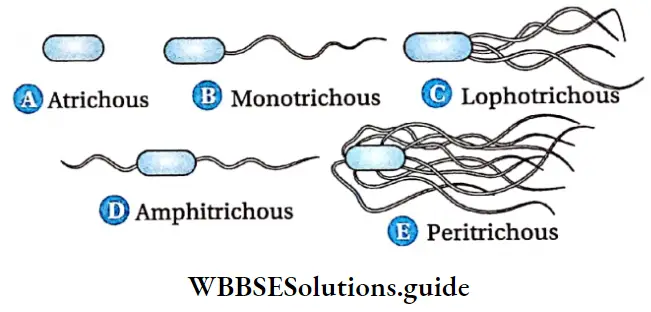
According to the mode of nutrition: On the basis of the mode of nutrition, bacteria may be classified into different types. These have been depicted through a flowchart on the next page.
Reproduction in bacteria: Bacteria reproduce by vegetative, asexual and sexual means.
Vegetative reproduction
- Binary fission: In this method, a single cell divides into two equal halves. Cells undergo division after every 20-30 minutes.
- Budding: In case of budding, the bacterial cell develops a small swelling. This swelling is called the bud. It gradually increases in size. DNA in the mother cell produces daughter DNA. The nucleus undergoes division first, forming two daughter nuclei. One such daughter nucleus remains with the mother cell and the other, along with some cytoplasm, moves to the bud. The pinched off bud gets separated from the mother cell by the formation of partition wall in between them. Thus another bacterial cell is formed. Examples are hyphomicrobium vulgare, Rhodomicrobium vannielia, etc.
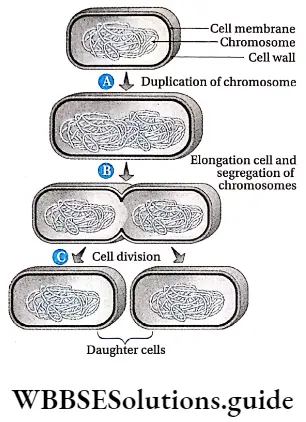
Archaebacteria Characteristics
Asexual reproduction
- Cyst formation: Cysts are formed by the deposition of additional wall or layer surrounding the mother cell wall. They survive the unfavourable conditions and germinate at the onset of favourable conditions. Example, many members of Azotobacter sp.
- Endospore formation: Endospores are formed during unfavourable environmental conditions like desiccation and starvation. The nucleoid replicates to form endospores with cytoplasmic material.
- On germination during favourable conditions, a spore gives rise to a normal bacterial cell. Example, Bacillus subtilis, Clostridium tetani, Escherichia coli, etc.
Sexual reproduction
- Conjugation: It is the transfer of genetic material between two bacterial cells, through plasmid. This occurs by direct cell-to-cell contact or by a tubular connection between two cells. It was discovered in 1946 by Joshua Lederberg and Edward Tatum.
- Transduction: It is the transfer of genetic material between bacterial cells by a virus (also known as vector). This virus is usually a bacteriophage. This was studied by Lederberg and Zinder in Salmonella sp. bacteria.
Classification of bacteria on the basis of mode of nutrition:
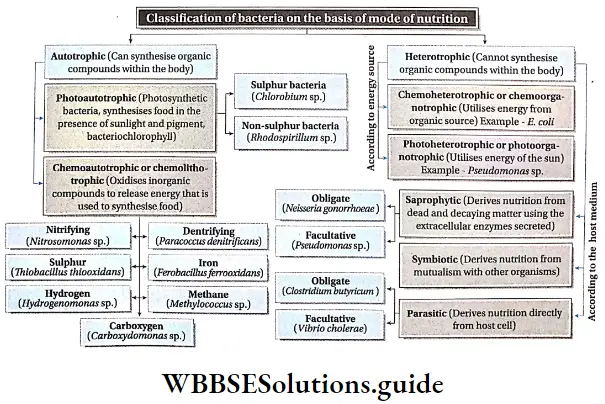
Transformation: It is the transfer of genetic material between bacterial cells by extraction or liberation of genes. Bacterial transformation was discovered by Griffith in Pneumococcus sp. (bacterial species causing pneumonia).
